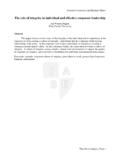Transcription of The European Nursing Leadership Foundation
1 The European Nursing Leadership Foundation A Literature Review on Team Leadership (based on a report for the Health Foundation ). David Dawes & Ali Handscomb December 2005. INTRODUCTION TO THE REPORT ..3. SECTION 1 - REVIEW OF THE KEY Leadership THEORIES ..3. INTRODUCTION TO Leadership THEORY ..3. - TRAIT THEORY ..3. - SITUATIONAL (CONTINGENCY) - TRANSACTIONAL AND TRANSFORMATIONAL Leadership ..4. - Leadership AND CHANGE ..5. - Leadership FOR HEALTHCARE - HEIFETZ AND ADAPTIVE Leadership ..6. - DRATH AND THE LIMITATIONS OF PERSONAL DOMINANCE AND INTERPERSONAL INFLUENCE ..7. - DEVELOPING LEADERS AND Leadership - DEFINING Leadership DEVELOPMENT ..8. - EFFECTIVE LEADER AND Leadership SECTION 2 - REVIEW OF TEAMS AND TEAM Leadership APPROACHES.
2 10. - INTRODUCTION ..10. - DEFINITIONS AND TYPES OF TEAMS ..10. CLASSIFICATIONS OF TEAMS ..11. - ADVANTAGES OF TEAM WORKING ..12. - TEAM PERFORMANCE AND Leadership ..13. THE IMPACT OF EFFECTIVE TEAM WORKING IN THE NHS ..16. - BUILDING TEAMS ..18. - EVIDENCE BASE FOR Leadership INTERVENTIONS ..20. Classroom-based learning ..20. 360-degree feedback ..20. Networks ..20. Assignments or Action learning - EVALUATING Leadership DEVELOPMENT PROGRAMMES ..20. Emotional Achieved learning objectives ..20. Behavioural Impact on the organisation ..20. - ORGANISATIONAL SUPPORT ..20. DOCTORS AND CLINICAL TEAM Leadership ..20. CONCLUSIONS FROM THE LITERATURE ..20. 3. REFERENCES.
3 20. APPENDIX A - TOOLS FOR EVALUATING AND MEASURING TEAM DEVELOPMENT, EFFECTIVENESS AND FOCUSED INSTRUMENTS ..20. MIDDLE-RANGE INSTRUMENTS ..20. BROAD-SPECTRUM INSTRUMENTS ..20. FULL-SPECTRUM INSTRUMENTS ..20. Page 2 of 37 European Nursing Leadership Foundation Introduction to the Report This report was compiled as part of a literature review on team Leadership conducted by the European Nursing Leadership Foundation . It has been reproduced here with the kind permission of the Health Foundation . The European Nursing Leadership Foundation is a not-for-profit social enterprise which supports Leadership development across Europe. More information can be found at Section 1 - Review of the Key Leadership Theories Introduction to Leadership theory This section incorporates the main theories on Leadership which influence both the thinking within the NHS and within the development for leaders offered by providers.
4 Most of the theory relates to single person Leadership rather than team Leadership and this reflects our findings that most development within teams occurs for individuals rather than whole teams. The end of this section outlines Leadership development and places some context on the theories discussed. Leadership is not new, indeed Plato refers to a higher function in humans who can lead others to enlightenment and represents an ideal. Ideas such as these have been built upon and extended but it is not until the eighteenth and nineteenth centuries that trait theory emerged where personal traits of individuals which were inherent rather than learned predicted Leadership capability.
5 - Trait theory This theory believes that leaders behave in various ways because they have inherent characteristics or dispositions. There are five predominant characteristics of Leadership : Self Confidence, Empathy, Ambition, Self-Control and Curiosity. The theory is that you are born a leader and that Leadership cannot be learned. To identify leaders or potential leaders then means that one looks for certain characteristics and appoints that person to a Leadership position. This has led to selection procedures being seen as more important than developing people (Hogan et al 1994). This theory has largely been discredited as no evidence has been found to uncover a consistent list of traits which could distinguish leaders from others.
6 One of the problems is that leaders who are successful in one field can be unsuccessful in another, whereas trait theory would suggest that they will be universally successful. A dramatic example of this was the influx of private sector managers and military officers who were brought into the NHS in the late 1980s after the Griffiths Report. Although many of them had had successful Page 3 of 37 European Nursing Leadership Foundation management careers outside the NHS, they found it difficult to work in the new culture and the majority left the NHS soon afterwards. Whilst trait theory may have been discredited it is largely responsible for the views that only certain people can be leaders and such attributes as charisma are essential.
7 Instead theories have become more concerned with context emphasising that the needs of the situation such as war or adversity would call forth the leader within and the correct leader would therefore emerge. - Situational (Contingency) Theory The next evolution in Leadership thinking was situational theory. This theory, sometimes also called contingency theory, emphasises that Leadership emerges in different situations to suit different needs and different environments. This idea was developed further by Blanchard and Hersey (1976) who argued that as well as adapting style to different contexts, leaders need to behave differently to suit the needs and maturity of their followers and there is no best way to lead or style of Leadership .
8 They argue that leaders need to develop a range of Leadership approaches and be able to diagnose which approach to use in a given situation. One strand of situational theory distinguishes between task and relationship centred leaders and was based on a managerial grid developed by Blake and Mouton (1964, 1978). John Adair (1993) is another author who has used a diagrammatic model of functional Leadership to represent the needs of the task, group and individual when relating to Leadership . This approach has been used widely in practice in the NHS and in particular as a corner stone of the Leading Empowered Organisations (LEO) national programme. There are a number of criticisms of this theory such as Handy (1993) who argues that this confuses Leadership style with situational decision making.
9 Elliott &. Walker argue that this approach is politically na ve as it contains a narrow definition of the impact which influence plays in the decision making process and in exercising Leadership (Elliott & Walker, 2003). Many of the critics of situational theory point out that there is an assumption that leaders have the ability to change styles depending on their environment, but there is little evidence to support this assertion. - Transactional and Transformational Leadership The idea of transformational and transactional Leadership was first developed by James McGregor Burns in 1978 and later developed by Bass and others. Transactional Leadership approaches followers with the intent of exchanging one thing for another ( using financial and status incentives).
10 Transactional Leadership is premised on motivating followers by some form of instrumental exchange, either a monetary or symbolic reward system. The focus is on the needs of the task and the organisation and how followers can be used to achieve Page 4 of 37 European Nursing Leadership Foundation those aims. There is little focus on the explicit needs of the followers. Bass et al (1987) argued that transformational Leadership is universally applicable and that regardless of culture, transformational leaders inspire followers to transcend their own self-interests for the good of the group or organisation (Bass et al 1987). Transformational Leadership is seen as being preoccupied with the development of followers rather than the achievement of targets (transactional Leadership ) and has been equated in some books as equivalent to Leadership as opposed to transactional Leadership which is equated to management.

















